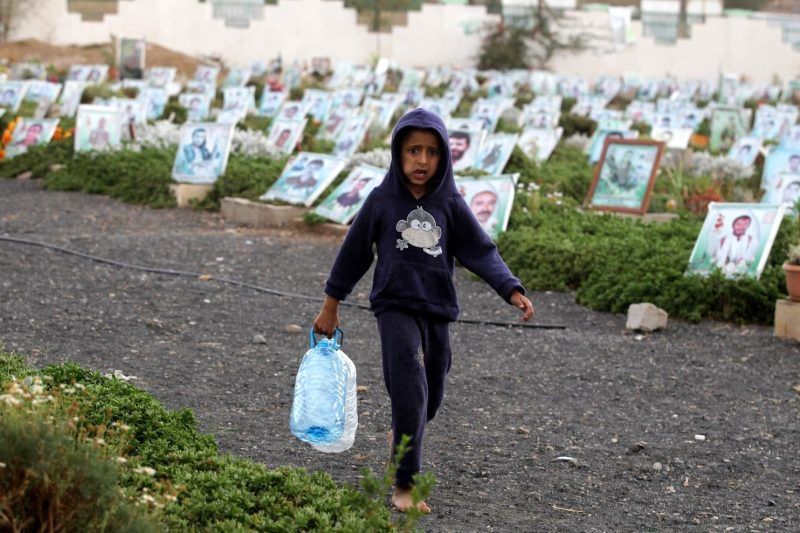
More than four years ago, adults started a war in Yemen despite knowing the terrible toll that violent conflict exacts on children.
The war in Yemen, now in its fifth year, continues to fuel the worst humanitarian crisis in the world. Indiscriminate violence and destruction have wreaked havoc on the civilian population and pushed millions to the brink. Yet it is Yemen’s children who suffer first and suffer most.
The consequences read like an itemized list of horrors. More than 6,700 children have been killed or seriously injured, while 12 million — more than 80 percent of all children across the country — need humanitarian assistance to survive. Basic services such as water, health care and sanitation have all but collapsed, and with the economy in free fall, families cannot afford to feed their children or bring them to health facilities.
In Yemen, a child dies every 10 minutes from preventable causes, including malnutrition and vaccine-preventable diseases. More than 1.8 million children are acutely malnourished, including 360,000 severely malnourished children who are fighting for their lives.
More than a quarter of children are out of school or in need of education assistance, and an estimated 2,000 schools can no longer be used. The journey to school has become so dangerous that parents are keeping their children home for fear of attacks. Without education, the future of millions of children and the country itself could be lost.
Conditions on the ground are not improving.
Since the Stockholm agreement was reached late last year between parties to the conflict, the situation has, if anything, worsened. Violence has escalated in some areas — including around Hajjah, north of Hodeidah — displacing more than 37,000 people, half of whom are children. Nearly 1.2 million children are living in 31 active conflict zones, either right on the front line or in areas witnessing heavy violence. Each day, it is estimated that eight children are killed or seriously injured.
Exposure to violence has a lifelong impact on children’s physical and emotional well-being. With little recourse for specialized care, many children will carry these scars into adulthood, with long-term consequences.
Meanwhile, humanitarian access to areas with active fighting has shrunk, leaving trapped civilians more vulnerable to malnutrition and disease outbreaks. Health and sanitation systems have deteriorated, increasing the risk that cholera and acute watery diarrhea will spread. Since January, nearly 109,000 cases of acute watery diarrhea/suspected cholera with 190 associated deaths have already been reported.
Simply put, Yemen remains a nightmare for children.
The question now is what can be done to protect Yemen’s children and safeguard the country’s future before time runs out. Any solution must start and end with putting children first.
For starters, parties to the conflict must make every possible effort to keep children safe and to abide by their legal obligations to keep them out of the line of fire — even in areas of active fighting. This also means sparing the essential infrastructure on which children depend, such as health centers, water and sanitation systems and schools. All parties to the conflict bear responsibility for killing and maiming children and using disproportionate force without consideration for the safety of children and other civilians. Those who have influence over the parties, including members of the U.N. Security Council, have an obligation to use that influence to protect children.
Parties must also allow unlimited imports of humanitarian and essential commercial supplies through all ports of entry to Yemen by sea, air and road, and remove all impediments that delay ground transportation within the country. Bureaucratic obstacles to the delivery of aid and to humanitarian and commercial imports should be eliminated, and parties should provide sustained, unconditional and uninterrupted humanitarian access to people in need — no matter who controls the areas they live in.
Yemeni authorities on both sides must do their share to pay the salaries of all civil servants, including health-care workers and teachers, in their areas — a step critical to restoring basic services for children. While the international community has stepped up to support paying small cash incentives, generosity is not enough for the millions of Yemeni children who no longer have access to education, health care or safe water.
The international community also has a key role to play. It must continue its financial support to help meet the immediate needs of children and make longer-term investments to establish a system of governance in Yemen that places the interest of children at its heart. Yemeni authorities, donors and humanitarian and development organizations should all find ways to sustainably provide longer-term cash assistance to the most vulnerable children and families.
But generosity alone is not going to bring an end to children’s suffering in the war-torn country. Any improvements in the conditions for children must be consolidated and preserved through a comprehensive and lasting peace agreement. Parties must work to reach a negotiated political solution, prioritizing and upholding the rights of children.
At the end of the day, the longer this war continues, the more children are going to die on the world’s watch. And if adults are the cause of Yemen’s downfall, they must take responsibility for the solution.
Henrietta Fore is executive director of UNICEF.
